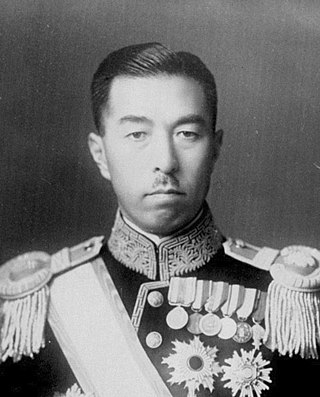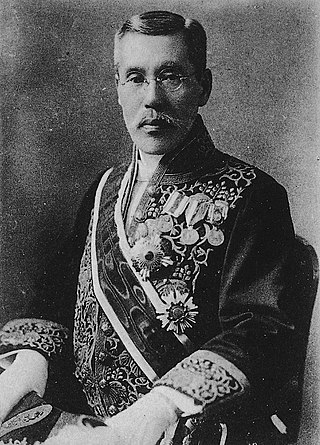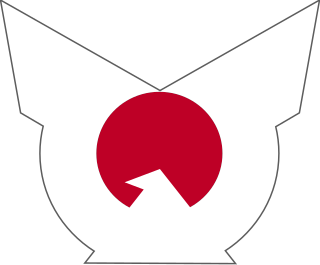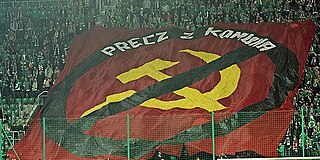
Prince Fumimaro Konoe was a Japanese politician who served as prime minister of Japan from 1937 to 1939 and from 1940 to 1941. He presided over the Japanese invasion of China in 1937 and the breakdown in relations with the United States, which ultimately culminated in Japan's entry into World War II. He also played a central role in transforming his country into a totalitarian state by passing the State General Mobilization Law and founding the Imperial Rule Assistance Association by dissolving all other political parties.

Kōki Hirota was a Japanese diplomat and politician who served as prime minister of Japan from 1936 to 1937. Originally his name was Jōtarō (丈太郎). He was executed for war crimes committed during the Second Sino-Japanese War at the Tokyo Trials.

Kiichirō Hiranuma was a prominent right-wing Japanese politician and Prime Minister of Japan in 1939. He was convicted of war crimes committed during World War II and was sentenced to life imprisonment.

Shigeru Yoshida was a Japanese diplomat and politician who served as prime minister of Japan from 1946 to 1947 and from 1948 to 1954. Yoshida was one of the longest-serving Japanese prime ministers, and is the third-longest serving prime minister of post-occupation Japan.

A Red Scare is a form of public hysteria provoked by fear of the supposed rise of leftist ideologies in a society, especially communism. Historically, "red scares" have led to mass political persecution, scapegoating, and the ousting of those in government positions who have had connections with left-wing to far-left ideology. The name is derived from the red flag, a common symbol of communism.

Sanzō Nosaka was a Japanese writer, editor, labor organizer, communist agent, politician, and university professor and the founder of the Japanese Communist Party (JCP). He was the son of a wealthy Japanese merchant, and attended the prestigious Keio University. While in university, Nosaka became interested in social movements, and joined a moderate labor organization after graduation, working as a research staff member, and as a writer and editor of the organization's magazine. He traveled to Britain in 1919 to study political economy, where he deepened his studies of Marxism and became a confirmed communist. Nosaka was a founding member of the Communist Party of Great Britain, but his activity within British communist circles led to him being deported from Britain in 1921.

The Communist International (Comintern), also known as the Third International, was an international organization founded in 1919 that advocated world communism, and which was led and controlled by the Communist Party of the Soviet Union. The Comintern resolved at its Second Congress in 1920 to "struggle by all available means, including armed force, for the overthrow of the international bourgeoisie and the creation of an international Soviet republic as a transition stage to the complete abolition of the state". The Comintern was preceded by the dissolution of the Second International in 1916.

The Italian Communist Party was a communist and democratic socialist political party in Italy. It was founded in Livorno as the Communist Party of Italy on 21 January 1921, when it seceded from the Italian Socialist Party (PSI), under the leadership of Amadeo Bordiga, Antonio Gramsci, and Nicola Bombacci. Outlawed during the Italian fascist regime, the party continued to operate underground and played a major role in the Italian resistance movement. The party's peaceful and national road to socialism, or the "Italian Road to Socialism", the realisation of the communist project through democracy, repudiating the use of violence and applying the Constitution of Italy in all its parts, a strategy inaugurated under Palmiro Togliatti but that some date back to Gramsci, would become the leitmotiv of the party's history.

The Anti-Comintern Pact, officially the Agreement against the Communist International was an anti-Communist pact concluded between Nazi Germany and the Empire of Japan on 25 November 1936 and was directed against the Communist International (Comintern). It was signed by German ambassador-at-large Joachim von Ribbentrop and Japanese ambassador to Germany Kintomo Mushanokōji. Italy joined in 1937, but it was legally recognised as an original signatory by the terms of its entry. Spain and Hungary joined in 1939. Other countries joined during World War II.

MarquessKōichi Kido was a Japanese statesman who served as Lord Keeper of the Privy Seal of Japan from 1940 to 1945, and was the closest advisor to Emperor Hirohito throughout World War II. He was convicted of war crimes and sentenced to life imprisonment, of which he served 6 years before being released in 1953.
The history of communism encompasses a wide variety of ideologies and political movements sharing the core theoretical values of common ownership of wealth, economic enterprise, and property. Most modern forms of communism are grounded at least nominally in Marxism, a theory and method conceived by Karl Marx during the 19th century. Marxism subsequently gained a widespread following across much of Europe and throughout the late 1800s its militant supporters were instrumental in a number of failed revolutions on that continent. During the same era, there was also a proliferation of communist parties which rejected armed revolution, but embraced the Marxist ideal of collective property and a classless society.

Japanese militarism refers to the ideology in the Empire of Japan which advocates the belief that militarism should dominate the political and social life of the nation, and the belief that the strength of the military is equal to the strength of a nation.
John Earl Haynes is an American historian who worked as a specialist in 20th-century political history in the Manuscript Division of the Library of Congress. He is known for his books on the subject of the American Communist and anti-Communist movements, and on Soviet espionage in America.

The Imperial Rule Assistance Association, or Imperial Aid Association, was the Empire of Japan's ruling political organization during much of Second Sino-Japanese War and World War II. It was created by Prime Minister Fumimaro Konoe on 12 October 1940, to promote the goals of his Shintaisei movement. It evolved into a "statist" ruling political party which aimed at removing sectionalism and factionalism from politics and economics in the Empire of Japan, creating a totalitarian one-party state in order to maximize the efficiency of Japan's total war effort in China. When the organization was launched officially, Konoe was hailed as a "political savior" of a nation in chaos; however, internal divisions soon appeared.

Tōhōkai was a Japanese fascist political party. The party was active in Japan during the 1930s and early 1940s. Its origins lay in the right-wing political organization Kokumin Domei which was formed by Adachi Kenzō in 1933. In 1936, Nakano Seigō disagreed with Adachi on of matters of policy and formed a separate group, which he called the 'Tōhōkai'.

Hotsumi Ozaki was a Japanese journalist working for the Asahi Shimbun newspaper, communist, Soviet intelligence agent, and advisor to Prime Minister Fumimaro Konoe. The only Japanese person to be hanged for treason by the Imperial Japanese government during World War II, Ozaki is well known as an informant of the Soviet agent Richard Sorge.

The Tientsin incident (天津事件) was an international incident created by a blockade by the Imperial Japanese Army's Japanese Northern China Area Army of the British settlements in the north China treaty port of Tientsin in June 1939. Originating as a minor administrative dispute, it escalated into a major diplomatic incident.
The Trautmann Mediation was an attempt by the German Ambassador to China, Oskar Trautmann, to broker a peace between Japanese Prime Minister Fumimaro Konoe and Chiang Kai-shek of the Chinese Nationalist government shortly after the Second Sino-Japanese War began. The mediation began in November 1937 and ended on January 16, 1938, with Konoe announcing its termination.

Anti-communism is political and ideological opposition to communist beliefs, groups, and individuals. Organized anti-communism developed after the 1917 October Revolution in the Russian Empire, and it reached global dimensions during the Cold War, when the United States and the Soviet Union engaged in an intense rivalry. Anti-communism has been an element of many movements and different political positions across the political spectrum, including anarchism, centrism, conservatism, fascism, liberalism, nationalism, social democracy, socialism, leftism, and libertarianism, as well as broad movements resisting communist governance. Anti-communism has also been expressed by several religious groups, and in art and literature.
A communist front is a political organization identified as a front organization under the effective control of a communist party, the Communist International or other communist organizations. They attracted politicized individuals who were not party members but who often followed the party line and were called fellow travellers.
















